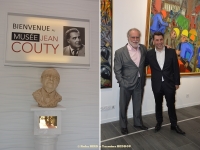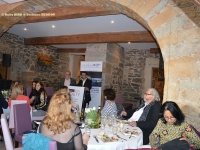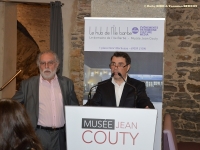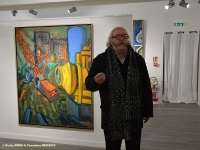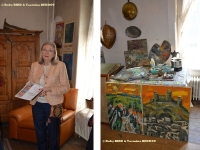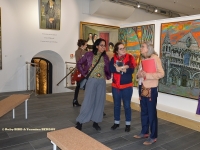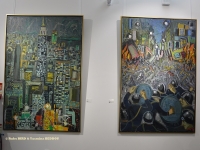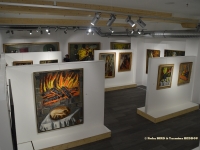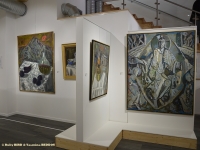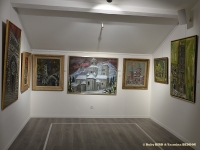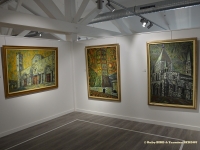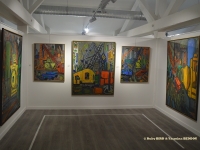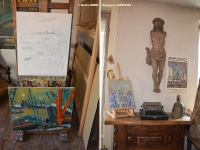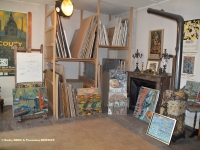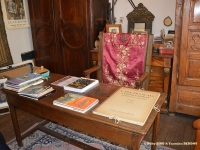Arts
MUSEE JEAN COUTY - Art Moderne & Contemporain in LYON (France)
Celebration of the Work of JEAN COUTY
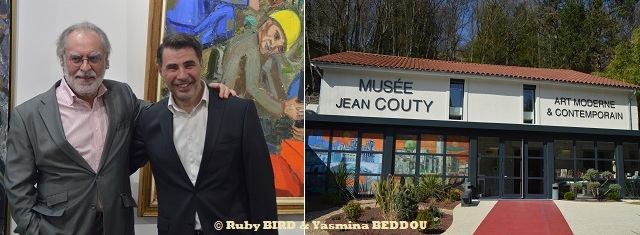
Edouard COUTY & Charles COUTY (Source: © Ruby BIRD & Yasmina BEDDOU)
USPA NEWS -
Born in 1907, Jean COUTY's devotion to the world of Art and Architecture first began when he entered the Ecole des Beaux Arts in LYON (France) in 1921, upon the advice of the man he would always consider his master, the Architect of French Modernity, Tony GARNIER (1869-1948)...
Born in 1907, Jean COUTY's devotion to the world of Art and Architecture first began when he entered the Ecole des Beaux Arts in LYON (France) in 1921, upon the advice of the man he would always consider his master, the Architect of French Modernity, Tony GARNIER (1869-1948).
Jean COUTY, in his early work, often drew his inspiration from his immediate surroundings: his family and the countryside around him. His family as was typical of their time and social standing, allowed him to experiment with the Art of the Portrait.
Jean COUTY, in his early work, often drew his inspiration from his immediate surroundings: his family and the countryside around him. His family as was typical of their time and social standing, allowed him to experiment with the Art of the Portrait.
He painted faces and situations which bore the stamp of reality and authenticity : his mother Eugénie and his sister Henriette (1931), the 'Bedridden Eugénie with her daughter, Henriette (1935), The Lone Woman (1935), The Father at Rest (1935), his Father Jean-François (1936 and 1937), Henriette drawing (1936), The Family Table (1937), Henriette reading (1937), Christiane, the wife of his brother, the Actor Julien COUTY (1938)...
Jean COUTY had not even turned twenty when he painted 'The Revolution in the Village (1936), followed by 'The Parable of the Mad Men (1937), then an analysis of the complex and authoritative world of the Christian Church with its many followers, ornate clothing, décorations and precious objects. Priests, monks, nuns and bishops would form the subjects of his intricate portrayal of the formidable world of the Catholic Church. 'Bread and Wine' central to the Catholic idea of sharing, would become the subject of some powerful still life paintings...
Jean COUTY always manifested a strong liking and talent for drawing. As a young man, he often made use of the presence of his family, encouraged by his sister, who shared his great talent. Jean COUTY showed his commitment to the Christian Church by honoring Bernadette Soubirou (1958)...
When Jean COUTY first entered the Lyon Art World, the concept of Modernity was essentially embodied by the 'Zinar Group', formed in 1920 at the initiative of Georges Albert TRESH (1881-1948), Etienne MORILLION (1885-1949), Adrien BAS (1884-1925, Pierre COMBET-DESCOMBES (1885-1966), Emile DIDIER (1890-1965), Louis BOUQUET (1885-1952), Antonin PONCHON (1891-1965), Marcel GIMOND (1894-1951)...
When Jean COUTY first entered the Lyon Art World, the concept of Modernity was essentially embodied by the 'Zinar Group', formed in 1920 at the initiative of Georges Albert TRESH (1881-1948), Etienne MORILLION (1885-1949), Adrien BAS (1884-1925, Pierre COMBET-DESCOMBES (1885-1966), Emile DIDIER (1890-1965), Louis BOUQUET (1885-1952), Antonin PONCHON (1891-1965), Marcel GIMOND (1894-1951)...
LYON at the end of the 19th Century, was the most modern City of FRANCE. The City Council has embarked on a subtantial series of city planning projects and, from 1895, suggested ideas for an industrial area Lyon's Berliet Factories werether birthplace of the first French cars. LYON was where the first airplanes were tried out. LYON was also where the 'Société Lumières' was perfecting the Cinematograph, between 1882 and 1885. The first Railway in FRANCE ran between LYON and SAINT-ETIENNE... Since the beginning of the Twentieth Century Artists had been experimenting with Modernity in the Art World of LYON.
At the Ecole des Beaux Arts in LYON, Jean COUTY counted among his teachers such people as : Auguste MORISOT (embrossing), Jules ARMBRUSTER (fine decor, perspective and stereotomy), Regis DEYGAS (live modelling), Georges DECÔTE (painting), Louis PROST (sculpture), Joseph DURIEUX (floral fabric decoration), Professor André (anatomy), Elise BOURDE (principles)...
Jean COUTY always felt a need to write about the History of Art. He also wrote in the 'Temps Nouveaux'. He was always guided by grand spiritual inspirations and by his undeniable culture, he paid frequent visits to PARIS where he attended exhibitions. Jean COUTY invariably expressed a real sense of commitment.
When interviewed by André WARNOD, Jean COUTY referred to his own Library thus 'I remain in constant touch with poets such as Claudel, Rilke, Garcia Lorca, Pierre Emmanuel, all those great Painters and great Architects whose work can be found reproduced in the albums and books which line the shelves of my Library'.
When interviewed by André WARNOD, Jean COUTY referred to his own Library thus 'I remain in constant touch with poets such as Claudel, Rilke, Garcia Lorca, Pierre Emmanuel, all those great Painters and great Architects whose work can be found reproduced in the albums and books which line the shelves of my Library'.
In 1977, in the Journal 'Tout Lyon', at the time of the 'Peintre et le Format Exibition' at the ELAC, René DEROUILLE recalled : 'In 1936, the victory of the Front Populaire' made such great impact on Jean COUTY who extoled the virtues of the workers, Jean COUTY doesn't follow the trend, he obeys the generosity of the Artist who, hidden away in his ivory tower, sees the struggle of those who yesterday cursed and exploited, and now, while in no way neglecting their duties, intend to see their rights honored. Jean COUTY's curiosity towards these daily hardships was characteristic of his quest...'
In 1959, Jean COUTY set out a Tour of FRANCE to study and paint 'Romanesques Churches : Saint-Lénonard, Saint-Michel de Cuxa in the Eastern Pyrenees, Linvernon in the Lot, Semur-en-Brionnais, Saint-Julien in the Haute-Vienne.... He was passionate about Cathedrals : Cahors, Guebwiller, Angoulême, Notre Dame de Paris... In 1961, Jean COUTY has caused a stir in PARIS when he exhibited twenty Romanesque Churches at the premises of Katia GRANOFF.
An inhabitant of LYON,originally from the Department of Creuse, competing with the best Artists of his time, such was Jean COUTY, when he was awarded the 'Prix de la Critique d'Art' in PARIS in 1950, together with Jean LE MOAL, a member of the LYON Group 'Témoignage'....
An inhabitant of LYON,originally from the Department of Creuse, competing with the best Artists of his time, such was Jean COUTY, when he was awarded the 'Prix de la Critique d'Art' in PARIS in 1950, together with Jean LE MOAL, a member of the LYON Group 'Témoignage'....
It would be impossible to discuss Jean COUTY' extensive work without talking about his collection 'Construction Sites'.They are like a triumphant song to a constantly evolving world, the breaking up of the old universe in which FRANCE & EUROPE, battered by the ravages of war, finally turned the page on the influence of the Second Empire and the Third Republic. This was time of full employment...
Source :
* Press Trip Musée Jean COUTY on March 16, 2017 - Art Moderne & Contemporain with Inauguration on March 17, 2017 and Opening to the Public on March 18, 2017
* Testimony of Charles COUTY, son of Jean COUTY : Founder and Director of Museum Jean COUTY
* Book 'Un Musée Un Livre" (Editions Mémoire des Arts)
Ruby BIRD
http://www.portfolio.uspa24.com/
Yasmina BEDDOU
http://www.yasmina-beddou.uspa24.com/
* Press Trip Musée Jean COUTY on March 16, 2017 - Art Moderne & Contemporain with Inauguration on March 17, 2017 and Opening to the Public on March 18, 2017
* Testimony of Charles COUTY, son of Jean COUTY : Founder and Director of Museum Jean COUTY
* Book 'Un Musée Un Livre" (Editions Mémoire des Arts)
Ruby BIRD
http://www.portfolio.uspa24.com/
Yasmina BEDDOU
http://www.yasmina-beddou.uspa24.com/
Liability for this article lies with the author, who also holds the copyright. Editorial content from USPA may be quoted on other websites as long as the quote comprises no more than 5% of the entire text, is marked as such and the source is named (via hyperlink).

